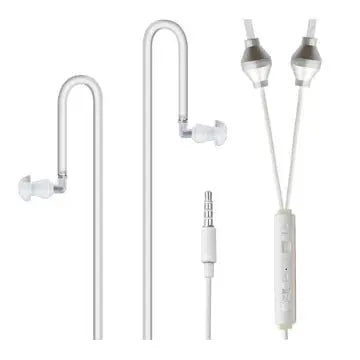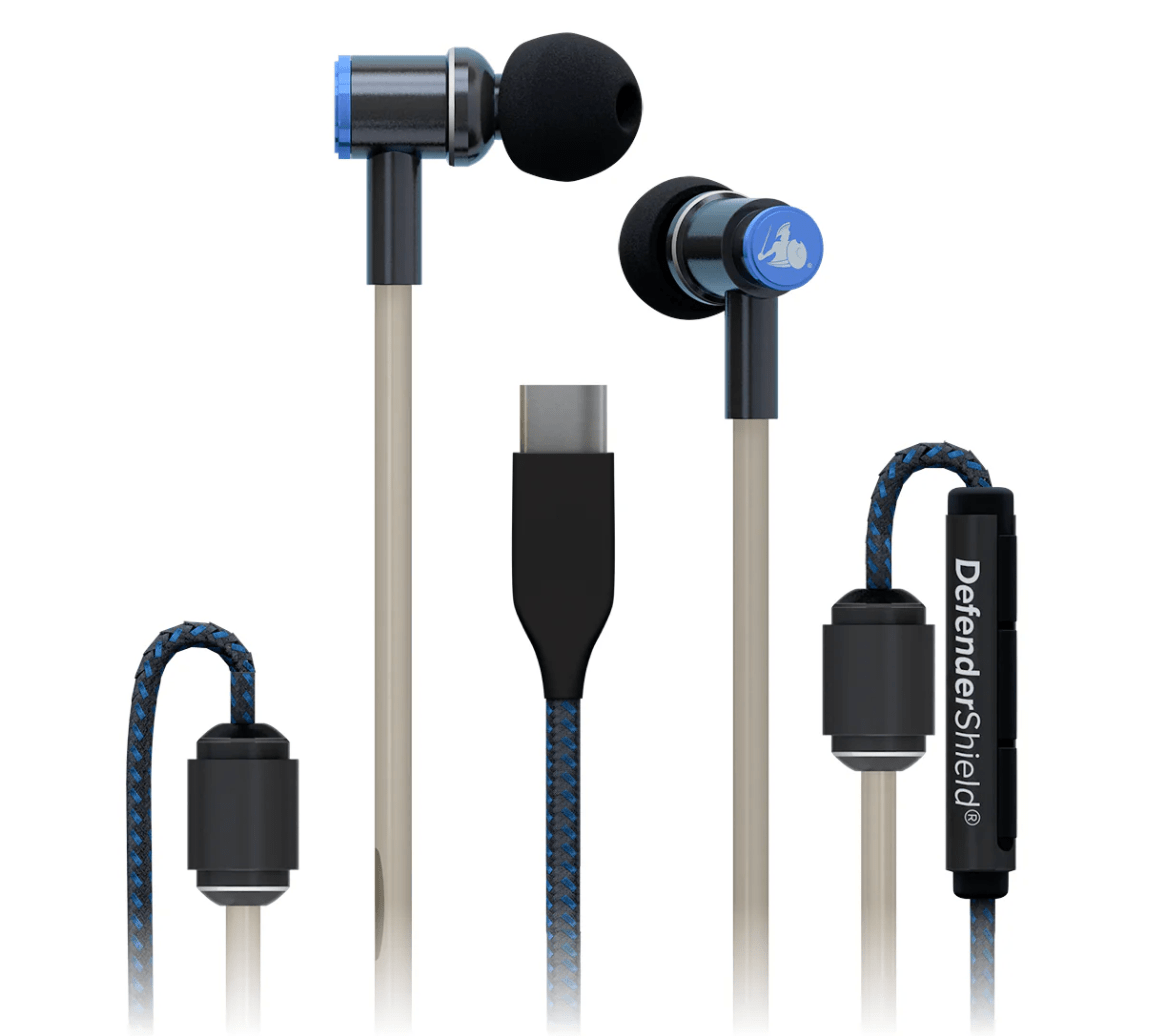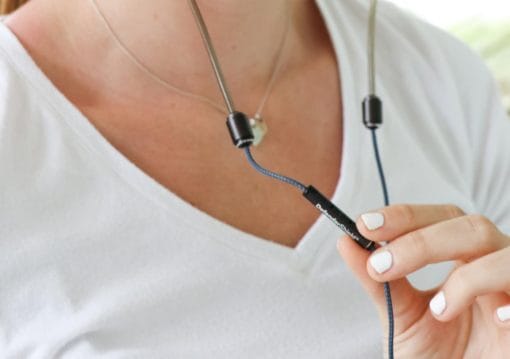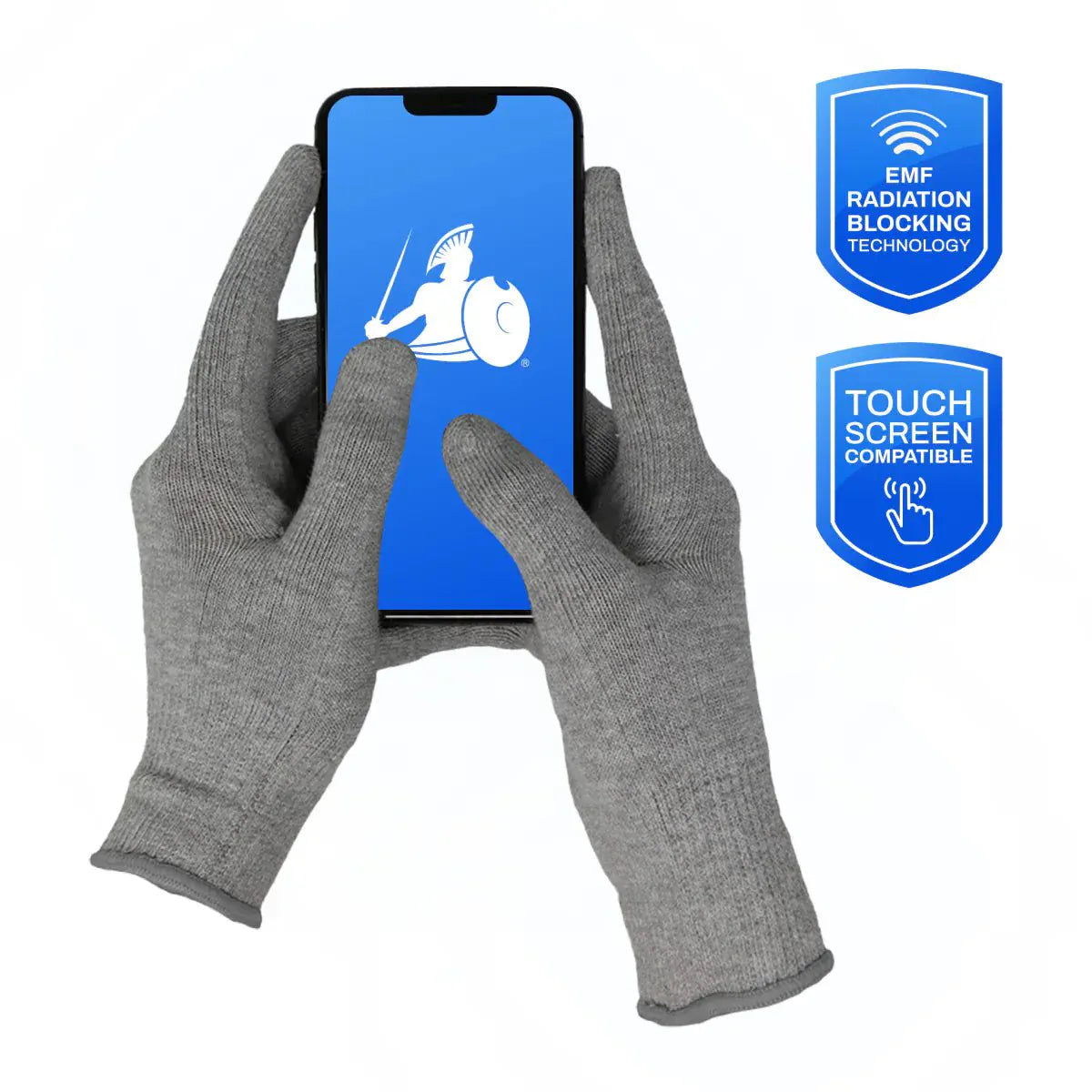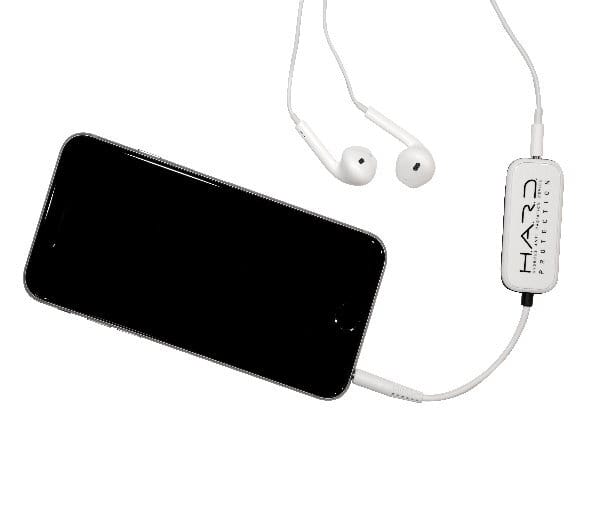What is EMF?
EMF stands for electromagnetic field and is defined as an electric and magnetic force field that surrounds a moving electric charge. It is sometimes referred to as electromagnetic radiation or EMR. Electromagnetic fields have different wavelengths and frequencies and are calculated in Hertz (Hz).
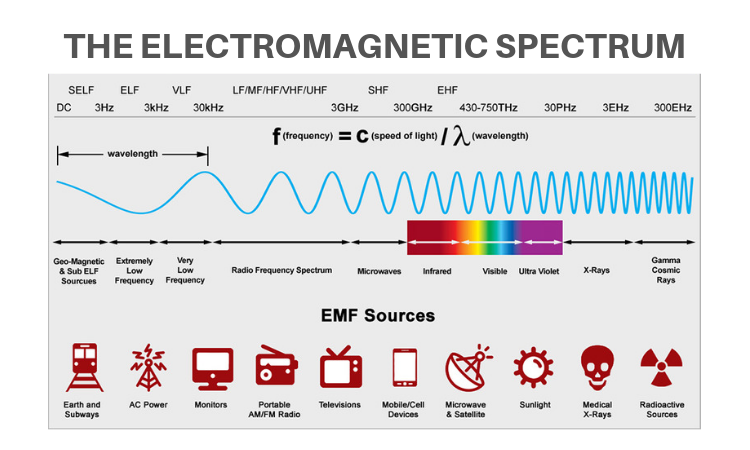
The Electromagnetic Spectrum illustration shows the range of EMF from low frequencies (on the left), like those found in a standard household power outlet, through to high frequency EMF classified as radio or microwave frequencies (RF). This type of EMF is emitted from mobile phones, mobile phone towers, tablets, cordless phones, WiFi routers, Bluetooth devices, smart meters, microwave ovens and many other sources.
At the far right of the Electromagnetic Spectrum sit the very high frequency EMFs and the ionising radiation found in X-Rays and Gamma Rays.
Measuring EMF
How we measure EMF depends on the type of EMF. Low frequency magnetic fields are measured using a Gauss Meter whereas low frequency electric fields are usually measured using a Multimeter. Instead of directly measuring the electric field, many building biologists measure them indirectly by measuring AC body voltage.
Radio frequencies from wireless technology, typically in the 10MHz to 8GHz range is measured using a Radio Frequency (RF) Meter.
See Measuring EMF for more information.
Surrounded by EMF
EMFs are everywhere; we can't see them or touch them or smell them but they surround us constantly. EMF exists in nature but it is the unprecedented increase of exposure to man-made EMF from new technology and smart devices in particular which is of growing concern to many scientists and health professionals.
Think about a typical day. Most of our homes are decked out with the latest mod-con appliances plugged in all day and emitting high levels of magnetic and electric fields. During a working day most of us will spend a considerable amout of time in close proximity to our smart phones and working wirelessly on a computer, laptop or tablet, bathing in a soup of radio frequency radiation. If we drive home at the end of day, most modern cars are now fitted with safety technology such as reverse cameras and sensors, car alarms and Bluetooth capability all of which contributes to our EMF exposure on a daily basis. If we travel by public transport we are surrounded by the phones and devices of our fellow passengers. Most public places now have free WiFi, our schools are wirelessly connected often with a WiFi router in every classroom and dozens of tablets or computers. The chances are, on any given day, we are being exposed to man-made EMFs at levels millions of times higher than you would naturally be exposed to in nature and levels millions of times higher than your body is designed to cope with.
An Increase in EMF Exposure
EMF exposure is only set to rise. According to GSMA Intelligence there are already 5 billion unique mobile phone subscribers globally with 75% of the global population expected to be connected by mobile by 2020. Also by 2020 an extra 3 to 5 billion people will be given access to the internet for the very first time and it is predicted that with the advent of the 'Internet of Things' (IoT) there will be around 50 billion devices, people or sensors all connected with each other.
To cope with this unprecedented demand means adding more mobile phone towers and upgrading our networks to 5G (read more about 5G here) which will essentially mean putting an EMF emitting antenna on virtually every street corner. Add to that Google's Project Loon network of wirelessly connected balloons floating around the stratosphere to help deliver internet connection to every corner of the planet and there really is little escape from EMF in our modern environment.
Should We Be Concerned About EMF?
There have been thousands of studies into the effects of EMF on human and animal health which conclude that we should be concerned about what this increased exposure to EMF from our phones and other smart technology might be doing to our health. See our page on EMF Research to some great links with more detailed information. However, for every study showing a link between EMF and harm to human health you will find a study which will disprove the theory, so the issue becomes confusing and overwhelming.
History has proven time and time again that when it comes to big industry and public health, lack of conclusive proof results in inaction even if there are clear early warning signs of a serious problem. It took almost 100 years from the first indication that asbestos might be harmful to human health for it to be banned in the EU. Smoking was identified as the most likely cause for lung cancer deaths back in 1949 and yet it took until 2005 to impose the first smoking ban in public places (in California, US) and 1.5 - 2 million people still die from lung cancer worldwide every year. When looking at the research into EMF and human health be sure to check whether it is an industry-funded study or an independently-funded study.
The International Agency for Research on Cancer (IARC), which is part of the World Health Organisation classifies electromagnetic fields from mobile phones (one of our greatest sources of EMF exposure) as a class 2B 'possible' carcinogen, that is to say something that could possibly cause cancer. WHO says 'the electromagnetic fields produced by mobile phones are classified by the International Agency for Research on Cancer as possibly carcinogenic to humans'
We hear a lot about the link between cancer and mobile phone use as these studies are usually the ones that hit the mainstream media but reported adverse health effects from EMF are numerous and can include:
- Skin problems
- Heart problems and high blood pressure
- Hormone disruptions
- Sleep disorders
- Anxiety and depression
- Asthma and allergies
- Heaches and migraines
- Memory disorders
- Lack of focus and concentration
- Hearing problems/tinnitus
- Nausea
- Numbness
- Joint and muscle pain
- Fatigue and weakness
- Electrohypersensitivity (EHS)
EMF Safety Standards
EMF exposure safety standards are in place and in Australia the governing body is ARPANSA (Australian Radiation Protection and Nuclear Safety Agency). Like most regulating bodies around the world, ARPANSA bases their EMF safety recommendations on the guidelines set by the International Commission on Non-Ionizing Radiation Protection (ICNIRP) which were first set in 1998. The ICNIRP guidelines are often criticised as being out-of-date and irrelevant to today's EMF exposure and the smart technologies that have been developed over the past 20 years. The number of mobile phones was far less back in 1998 than it is today and tablets and smart meters didn't even exist. The guidelines however are still in use today.
In July 2018 ICNIRP issued draft guidelines for limiting exposure to radiofrequency EMF (in the 100kHz to 300GHz range) but EMF scientists and NGOs around the world issued a press release calling for more protective limits: 'The guidelines are inadequate to protect humans and the environment, as they only protect against acute thermal effects from very short and intense exposure. They do not protect against cancer, reproductive harm, or effects on the nervous system, although the preponderance of the peer-reviewed research has found adverse effects from chronic exposure at intensities below the ICNIRP limits'
Mobile Phone Safety Standards
Of all the government regulations on EMF the only one that manufacturers of mobile phones and other wireless devices that emit radio frequency EMF have to comply with is the Specific Absorption Rate or SAR. The SAR limit for mobile phone handsets in Australia is 2W/kg averaged over 10 grams.
There has been some criticism about the way mobile phone SAR limits are tested, including the length of time of the 'call' during the testing, the size of the test dummy's head being larger than the average person's head and the fact that during testing the phone is held 5mm away from the body (which wouldn't be the case in real life if you were carrying your phone in your pocket or bra). All mobile phones carry a RF Exposure safety warning in the legal section of the phone or on the manufacturer's website. It's important to read this for your particular phone model to understand how to use your phone and stay within recommended safety guidelines. On a typical iPhone this would be found by going to Settings > General > About > Legal > RF Exposure
The Precautionary Principle
While the science on EMF continues to be debated, the advice from scientists and health professionals working in EMF health is to adopt the precautionary principle and reduce our exposure to EMF, something which countless groups of scientists and citizens around the world have been calling for over the last 15 years and more.
Some countries around the world have already adopted a precautionary approach to EMF safety on a national level in numerous ways; warning labels appear on mobile phones in Israel, Belgium, France and most recently in the City of Berkeley, California; restrictions around placements of mobile phone antennas are now in place in New Zealand, Greece, France, Chile, India and Canada. Many countries including France, Israel, Italy, Ireland, Canada and Finland are looking at ways to protect children who are more susceptible to the effects of EMF (see our page Children and EMF for more details) by either restricting use of WiFi in schools or adopting stricter guidelines around the selling and marketing of mobile phones to children.
We can all adopt the precautionary principle to EMF by reducing our own personal exposure in everyday life. There are some easy, quick fixes that can be implemented straight away to make using your wireless technology safer. See our page Reducing Your Exposure for more details on ways to protect you and your family.
5 Quick Ways to Reduce Your Exposure to EMF
1. Don't hold your phone to your head. Text instead of call, use the loud speaker function when possible or an AirTube headset. Distance is your friend, exposure is lessened the further you are from the source of EMF.
2. Don't carry your phone or wireless device on your body i.e.: in a pocket or a bra. Always keep distance between the device and your body or consider an anti-radiation shielding case
3. Turn your WiFi router off at night to reduce EMF levels in your home while you're asleep.
4. Use the Airplane Function on your devices when possible and especially when being used by children. This cuts off the signal between the device and the WiFi router or mobile phone tower, dramatically reducing the EMF radiation levels
5. Remove all EMF emitting devices from your bedroom. If you still use your phone as your alarm clock then switch your phone to Airplane Mode or consider treating yourself to an old-fashioned alarm clock.

